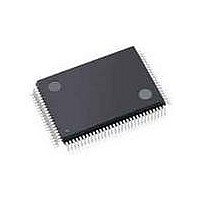C8051F040-TB Silicon Laboratories Inc, C8051F040-TB Datasheet - Page 231

C8051F040-TB
Manufacturer Part Number
C8051F040-TB
Description
BOARD PROTOTYPING W/C8051F040
Manufacturer
Silicon Laboratories Inc
Type
MCUr
Specifications of C8051F040-TB
Contents
Board
Processor To Be Evaluated
C8051F04x
Interface Type
USB
Lead Free Status / RoHS Status
Contains lead / RoHS non-compliant
For Use With/related Products
C8051F040
Lead Free Status / Rohs Status
Lead free / RoHS Compliant
- Current page: 231 of 328
- Download datasheet (3Mb)
18.2. CAN Registers
CAN registers are classified as follows:
1. CAN Controller Protocol Registers: CAN control, interrupt, error control, bus status, test
2. Message Object Interface Registers: Used to configure 32 Message Objects, send and
3. Message Handler Registers: These read only registers are used to provide information to
4. CIP-51 MCU Special Function Registers (SFR): Six registers located in the CIP-51 MCU
18.2.1. CAN Controller Protocol Registers
The CAN Control Protocol Registers are used to configure the CAN controller, process interrupts, monitor
bus status, and place the controller in test modes. The CAN controller protocol registers are accessible
using CIP-51 MCU SFR’s by an indexed method, and some can be accessed directly by addressing the
SFR’s in the CIP-51 SFR map for convenience.
The registers are: CAN Control Register (CAN0CN), CAN Status Register (CAN0STA), CAN Test Register
(CAN0TST), Error Counter Register, Bit Timing Register, and the Baud Rate Prescaler (BRP) Extension
Register. CAN0STA, CAN0CN, and CAN0TST can be accessed via CIP-51 MCU SFR’s. All others are
accessed indirectly using the CAN address indexed method via CAN0ADR, CAN0DATH, and CAN0DATL.
Please refer to the Bosch CAN User’s Guide for information on the function and use of the CAN Control
Protocol Registers.
18.2.2. Message Object Interface Registers
There are two sets of Message Object Interface Registers used to configure the 32 Message Objects that
transmit and receive data to and from the CAN bus. Message objects can be configured for transmit or
receive, and are assigned arbitration message identifiers for acceptance filtering by all CAN nodes.
Message Objects are stored in Message RAM, and are accessed and configured using the Message
Object Interface Registers. These registers are accessed via the CIP-51’s CAN0ADR and CAN0DAT reg-
isters using the indirect indexed address method.
Please refer to the Bosch CAN User’s Guide for information on the function and use of the Message Object
Interface Registers.
modes.
receive data to and from Message Objects. The CIP-51 MCU accesses the CAN mes-
sage RAM via the Message Object Interface Registers. Upon writing a message object
number to an IF1 or IF2 Command Request Register, the contents of the associated
Interface Registers (IF1 or IF2) will be transferred to or from the message object in CAN
RAM.
the CIP-51 MCU about the message objects (MSGVLD flags, Transmission Request
Pending, New Data Flags) and Interrupts Pending (which Message Objects have caused
an interrupt or status interrupt condition).
memory map that allow direct access to certain CAN Controller Protocol Registers, and
Indexed indirect access to all CAN registers.
Step 4. Write the value 0x5EC0 to the [CAN0DATH:CAN0DATL] CIP-51 SFRs to set the Bit
Step 5. Perform other CAN initializations.
Timing Register using the indirect indexing method described on
232.
Rev. 1.5
C8051F040/1/2/3/4/5/6/7
Section 18.2.5 on page
231
Related parts for C8051F040-TB
Image
Part Number
Description
Manufacturer
Datasheet
Request
R
Part Number:
Description:
SMD/C°/SINGLE-ENDED OUTPUT SILICON OSCILLATOR
Manufacturer:
Silicon Laboratories Inc
Part Number:
Description:
Manufacturer:
Silicon Laboratories Inc
Datasheet:
Part Number:
Description:
N/A N/A/SI4010 AES KEYFOB DEMO WITH LCD RX
Manufacturer:
Silicon Laboratories Inc
Datasheet:
Part Number:
Description:
N/A N/A/SI4010 SIMPLIFIED KEY FOB DEMO WITH LED RX
Manufacturer:
Silicon Laboratories Inc
Datasheet:
Part Number:
Description:
N/A/-40 TO 85 OC/EZLINK MODULE; F930/4432 HIGH BAND (REV E/B1)
Manufacturer:
Silicon Laboratories Inc
Part Number:
Description:
EZLink Module; F930/4432 Low Band (rev e/B1)
Manufacturer:
Silicon Laboratories Inc
Part Number:
Description:
I°/4460 10 DBM RADIO TEST CARD 434 MHZ
Manufacturer:
Silicon Laboratories Inc
Part Number:
Description:
I°/4461 14 DBM RADIO TEST CARD 868 MHZ
Manufacturer:
Silicon Laboratories Inc
Part Number:
Description:
I°/4463 20 DBM RFSWITCH RADIO TEST CARD 460 MHZ
Manufacturer:
Silicon Laboratories Inc
Part Number:
Description:
I°/4463 20 DBM RADIO TEST CARD 868 MHZ
Manufacturer:
Silicon Laboratories Inc
Part Number:
Description:
I°/4463 27 DBM RADIO TEST CARD 868 MHZ
Manufacturer:
Silicon Laboratories Inc
Part Number:
Description:
I°/4463 SKYWORKS 30 DBM RADIO TEST CARD 915 MHZ
Manufacturer:
Silicon Laboratories Inc
Part Number:
Description:
N/A N/A/-40 TO 85 OC/4463 RFMD 30 DBM RADIO TEST CARD 915 MHZ
Manufacturer:
Silicon Laboratories Inc
Part Number:
Description:
I°/4463 20 DBM RADIO TEST CARD 169 MHZ
Manufacturer:
Silicon Laboratories Inc










